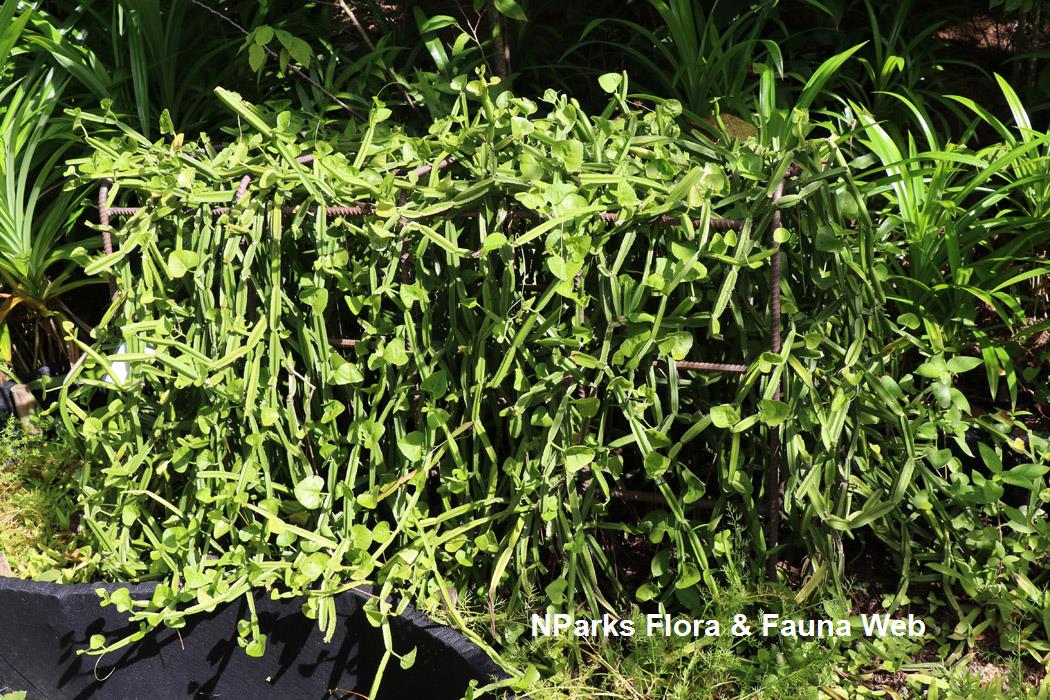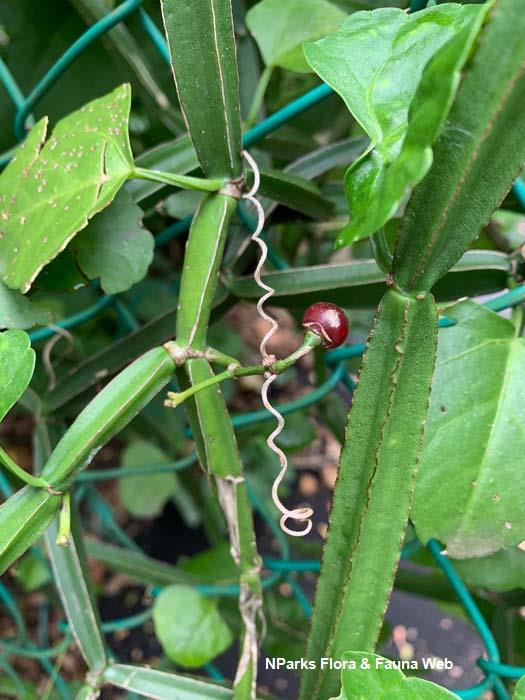
Back
Cissus quadrangularis L.
| Family Name: | Vitaceae |
| Common Name: | Four-angled vine, Veldt Grape, 方茎青紫葛 |
Cissus quadrangularis is a climbing succulent belonging to the grape family. It has four-angled winged stems and broad ovate leaves, with reddish flower buds that open to white petals.
Name
Classifications and Characteristics
| Plant Division | Angiosperms (Flowering Seed Plants) (Dicotyledon) |
|---|---|
| Plant Growth Form | Climber |
| Lifespan (in Singapore) | Perennial |
| Mode of Nutrition | Autotrophic |
| Maximum Height | 1 m to 5 m |
| Maximum Plant Spread / Crown Width | 1 m to 5 m |
Biogeography
| Native Distribution | India, South Africa, Southeast Asia |
|---|---|
| Native Habitat | Terrestrial |
| Preferred Climate Zone | Tropical |
Description and Ethnobotany
| Growth Form | It is a climbing herb with tendrils. |
|---|---|
| Foliage | Its simple leaves are green, broad-ovate.The tendril grows in the opposite direction of the leaf on the same node. |
| Stems | Thick, succulent, quadrangular with angles winged, constricted at notes. Each node has a tendril emerging from the opposite side of the node. |
| Flowers | Its whitish flowers are inconspicuous. The flower buds are pinkish red. |
| Fruit | Its fruit are ovoid, turning red when ripe. |
| Cultivation | Plant require support for climbing. |
| Etymology | The species epithet 'quadrangularis' means 'four-angled', referring to the stems. |
| Ethnobotanical Uses | Medicinal: The powdered root and crushed leaves are used in treatment of broken bones and injured ligaments. The leaves or young stems are used to cure wounds and burns. |
Landscaping Features
| Desirable Plant Features | Ornamental Stems |
|---|---|
| Landscape Uses | General, Parks & Gardens, Suitable for Hanging Baskets |
Fauna, Pollination and Dispersal
| Fauna Pollination Dispersal Associated Fauna | Bee-Attracting |
|---|---|
| Pollination Method(s) | Biotic (Fauna) (Insects (Bee)) |
Plant Care and Propagation
| Light Preference | Semi-Shade |
|---|---|
| Water Preference | Moderate Water |
| Plant Growth Rate | Fast to Moderate |
| Rootzone Tolerance | Well-Drained Soils |
| Propagation Method | Seed, Stem Cutting |
Foliar
| Foliage Retention | Evergreen |
|---|---|
| Mature Foliage Colour(s) | Green |
| Mature Foliage Texture(s) | Smooth |
| Prominent Young Flush Colour(s) | Green |
| Young Flush Texture(s) | Smooth |
| Foliar Modification | Foliar Tendril |
| Foliar Type | Simple / Unifoliate |
| Foliar Arrangement Along Stem | Alternate |
| Foliar Attachment to Stem | Petiolate |
| Foliar Shape(s) | Non-Palm Foliage (Ovate) |
| Foliar Venation | Pinnate / Net |
| Foliar Margin | Entire, Serrate / Toothed |
| Foliar Apex - Tip | Acute |
| Foliar Base | Cordate |
Non - Foliar and Storage
| Stem Type & Modification | Climbing Tendril, Herbaceous |
|---|---|
| Root Type | Underground |
Floral (Angiosperm)
| Flower & Plant Sexuality | Bisexual Flowers |
| Flower Colour(s) | Pink, White |
|---|---|
| Flower Texture(s) | Smooth |
| Flower Grouping | Cluster / Inflorescence |
| Flower Location | Axillary |
| Flower Symmetry | Radial |
Fruit, Seed and Spore
| Mature Fruit Colour(s) | Red |
|---|---|
| Mature Fruit Texture(s) | Smooth |
| Fruit Type | Fleshy Fruit , Non-Accessory Fruit |
| Seed Quantity Per Fruit | Few (1-5) |
Image Repository
Others
| Master ID | 31275 |
|---|---|
| Species ID | 5671 |
| Flora Disclaimer | The information in this website has been compiled from reliable sources, such as reference works on medicinal plants. It is not a substitute for medical advice or treatment and NParks does not purport to provide any medical advice. Readers should always consult his/her physician before using or consuming a plant for medicinal purposes. |

.jpg)
.jpg)
.jpg)












